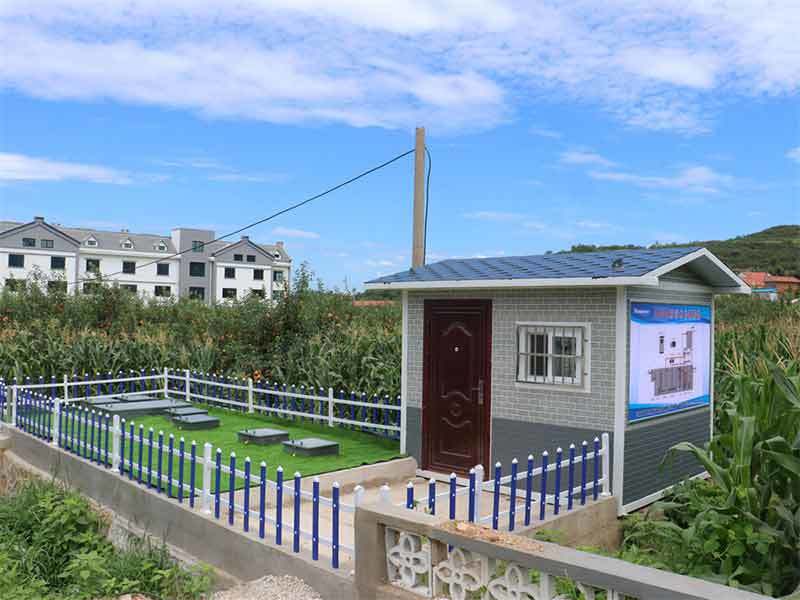- Overview
-
- Commodity name: bioreactor
I. Basic Requirements
Sewage treatment equipment shall be installed below the ground level. The foundation elevation must be constructed strictly in accordance with the drawings, and the foundation concrete shall be poured as required by the drawings. The foundation must remain level and must not be tilted. In northern regions, the inspection holes of the equipment shall be raised, and the equipment shall be placed below the frozen soil layer.
II. Operation Instructions
The mixed wastewater generated during the production process is discharged into the equalization tank through the grille tank. A fine grille is installed in the grille tank at the inlet of the equalization tank to remove suspended solids and floating substances contained in the wastewater.
The sewage enters the equalization tank through the grille. In the equalization tank, the water volume and water quality are adjusted. After the water volume and quality become uniform, the sewage is lifted by the sewage pump to the underground integrated treatment equipment (A/O process) for treatment.
Two sewage lift pumps are installed in the equalization tank of the civil structure, adopting the operation mode of "one in use and one standby". The start and stop of the pumps are controlled by liquid level: the pumps start at high water level and stop at low water level. After the sewage is delivered to the integrated sewage treatment equipment by the lift pumps, it undergoes a series of biochemical reactions through the anaerobic and aerobic stages in sequence, and then enters the secondary sedimentation tank. A sludge lift pump is installed in the secondary sedimentation tank for lifting sludge to the sludge tank, and this pump is controlled by a time relay. The sludge in the sludge tank is returned to the anaerobic tank, while the supernatant in the secondary sedimentation tank flows into the buffer tank by gravity. Then, the sewage is lifted by the sewage pump to the quartz sand filter and activated carbon filter for filtration. The filtered water enters the clear water tank and is discharged after meeting the standards. Meanwhile, a backwash pump is equipped in the clear water tank, which uses the treated clear water to backwash the quartz sand filter and activated carbon filter.

III. Power Connection and Water Test
After the equipment is positioned, pipelines are connected, and installation is completed, connect the power cords of the water pumps, fans, and electrical control cabinets. First, check whether the fans are filled with engine oil and whether the circuit wiring is correct; then start the equipment for trial operation, check whether the rotation direction of the water pumps and fans meets the requirements, and whether the working current of each motor is consistent with the instructions. Only after confirming that all electrical equipment is installed correctly can the equipment be started for water test.
During the water test, first fill all water storage parts of the equipment's tanks and all pipelines with water for full-water leak test. After observing and confirming that there is no leakage, start the fans, check the aeration situation in the aeration tank, and adjust the valves to make the aeration volume uniform.
After the water test, the equipment must be fully buried by backfilling with fine soil layer by layer. It is strictly forbidden to use large pieces of brick, stone, or rock for backfilling to prevent damage to the connecting pipelines outside the equipment.

IV. Commissioning and Operation
-
Pump sewage into the equipment, turn on the fans for aeration. Stop pumping when the aerobic tank is full of water, and conduct commissioning and operation according to the following methods:① Artificial Cultivation of Biofilm:Pump domestic sewage into the integrated equipment, then stop the water inflow. Add anaerobic activated sludge into the anaerobic tank and aerobic activated sludge into the aerobic tank, followed by continuous aeration (i.e., "closed aeration"). During closed aeration, the water temperature should be controlled between 15℃ and 25℃, and the closed aeration time is 2-3 days; if the temperature is low, the closed aeration time should be extended to 5-7 days. Add a small amount of glucose into the water every day (dissolve half a small bag in water before adding), and observe the surface condition of the filler in the contact oxidation tank. When a layer of orange-black mucous membrane grows on the surface of the filler, it indicates that the biofilm cultivation is completed. This process usually takes 7-15 days, after which the equipment can be switched to normal operation.
② Sludge Cultivation and Water Change:Water change is required after 2-3 days of closed aeration. Continue to pump domestic sewage into the aerobic tank (biochemical tank), and continue closed aeration after changing water for 3 hours every day. This operation should last for 5-6 days. The purpose of water change is to supplement new nutrients to the oxidation tank, and finally realize continuous water inflow and normal operation until fuzzy sludge flocs appear on the filler of the biochemical tank, and microbial flocs can be observed under a magnifying glass. During this process, the secondary sedimentation tank should discharge water continuously, and the precipitated sludge is returned to the aeration tank. Mature sludge has good sedimentation performance and contains a large number of microbial flocs and ciliate protozoa (such as Vorticella, Spirorbis, Opercularia, etc.). The removal rate of BOD5 (5-day Biochemical Oxygen Demand) in domestic sewage can reach 90%.
-
Precautions:(1) Domestic sewage contains comprehensive and balanced nutrients and a large number of microorganisms, which can improve the equipment's ability to decompose organic matter. If closed aeration is carried out for a long time without water inflow, the dissolved oxygen in the aeration tank will be too high, accelerating the aging and shedding of the biofilm itself.(2) Adjust the oxygen supply valve of the aeration tank to keep the aeration volume within an appropriate range. The aeration volume must not be too small; otherwise, the biofilm on the filler will die (characterized by blackening of the biofilm), resulting in the loss of water purification capacity.(3) Nutrient Ratio: Generally, the content ratio of BOD5, nitrogen (N), and phosphorus (P) in sewage should meet BOD5:N:P = 100:5:1, with the minimum requirement of BOD5:N:P = 100:2:0.5. During the sludge cultivation stage, the proportion of nitrogen and phosphorus should be appropriately increased.(4) Temperature Requirement: The minimum temperature during sludge cultivation should be maintained above 15℃.
-

V. Normal Operation
- After the commissioning is completed, the equipment can enter the normal operation state. The operations of water inflow, aeration, and sedimentation shall be carried out according to the treatment capacity of the equipment. During operation, it is necessary to ensure that the aeration volume meets the normal operation standard, and at the same time, regularly check the operation status of the water pumps and fans to prevent accidents.
- After biochemical treatment, the sewage flows into the sedimentation tank by gravity. After sedimentation, it flows into the filter tank by gravity, and then is pumped to the clear water tank by the water pump.
- The effluent from the clear water tank is lifted by the lift pump and discharged.
Keywords:
Messages
Contact: +86 18016210178 (Ms.Liu)
Add:No.56, Donghuan Road, Zhucheng City, Weifang City, Shandong Province






